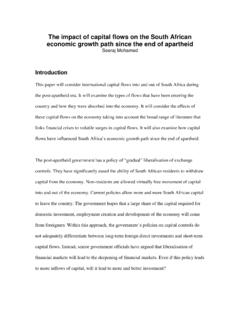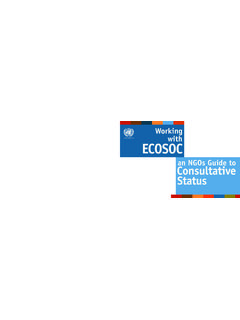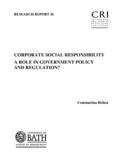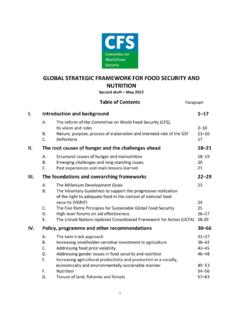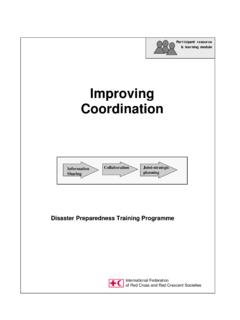Transcription of The Role and Structure of Civil Society …
1 AUGUR Challenges for Europe in the world in 2030 Project no. SSH-CT-2009-244565 Collaborative Project WP6 the role and Structure of Civil Society Organizations in National and Global Governance Evolution and outlook between now and 2030 Fabrice DESSE (Fifth draft June 2012) Project co-funded by the European Commission within the Seventh Framework Programme (2007- 2013) Dissemination Level PU Public X PP Restricted to other programme participants (including the Commission Services) RE Restricted to a group specified by the consortium (including the Commission Services) CO Confidential, only for members of the consortium (including the Commission Services) 2 Abstract The last decade has witnessed a tremendous growth of non-governmental actors, such as ngos or labor unions, commonly referred to as Civil Society Organizations (CSOs).
2 This has followed the trend of the globalization of social, economical and environmental issues which are less and less limited to a specific country or field. The purpose of this paper is to draw a global picture of the weight and influence of CSOs at a national and global level and then to make assumptions of their future evolution until 2030 through a set of four scenarios. In a first part, we thus define three main criteria to evaluate CSOs power: the capacity, the sustainability and the impact of CSOs.
3 Thanks to these criteria, we try to compare the weight and Structure of the Civil Society sector by country: we study their human resources (both paid staff and volunteers), their sources of revenue and their distribution amongst fields of intervention. This allows us to regroup countries in five country clusters which correspond to a specific typology of the development of the Civil Society sector: the Liberal (Anglo-Saxon) model, the Welfare Partnership (Western European and Mediterranean) model, the Social Democratic (Nordic) model, the Deferred Democratization (Latin American, Eastern and Central European, Industrialized Asian) model and the traditional (African and Indian) model.
4 In the second part of this paper, we study the power and Structure of CSOs at a global level. We analyze the frame of intervention of CSOs and their relationship with major international institutions: the United Nations, the European Union, the World Bank, the International Monetary Fund and the World Trade Organization (as well as transnational corporations). For each organization, we characterize the main trends which have marked the evolution of their relationship with CSOs, especially since the 2000s and the break-up of the Washington Consensus, in order to be able to make assumptions regarding the future.
5 We conclude this paper with a prospective view of CSOs through a set of four macro-economic and financial scenarios of the AUGUR project1: Reduced Government, China and US intervention, Regionalisation and Multipolar Collaboration. For each scenario we try to characterize the main trends of the power and Structure of CSOs by 2030, both at a regional and global level, especially regarding the evolution of the regional typologies identified in our first part and the impact of financial and environmental CSOs regarding global environmental issues and financial regulation.
6 1 3 Table of Contents I. Introduction and definition of Civil Society organizations ..5 A. Definition of Civil Society organizations .. 7 B. Types of CSOs .. 8 C. Types of actions: service provision and advocacy .. 9 D. CSOs and Welfare State: complementarity and substitution .. 10 E. Accountability issues regarding CSOs .. 11 II. CSOs power and Structure at a national and regional level 13 A. A quantitative approach based on three main criteria: the capacity, the sustainability and the impact of CSOs.
7 14 B. Variation of CSOs weight and Structure by country .. 15 C. Variation of CSOs weight and Structure by field of intervention .. 19 D. CSO s revenue Structure .. 25 E. Typology of countries regarding the Civil Society sector .. 27 1. The Liberal (Anglo-Saxon) model .. 28 2. The Social Democratic (Nordic) model .. 30 3. The Welfare Partnership (Western European) model .. 31 4. The Deferred Democratization model (Latin America, Eastern Europe and CIS, Industrialized Asia) 33 5. The Traditional model (Africa, India and other developing countries with high poverty rates) 34 III.
8 CSOs role in global governance .. 37 A. Types and main strategies of Civil actors at a global level .. 38 1. Main means and strategies of global CSOs to gain capacity, sustainability and impact .. 38 2. Types of Civil actors at a global level .. 39 B. The frame of intervention of CSOs in the United Nations and the European Union .. 41 C. CSOs and the international development strategy .. 43 1. CSOs relationship with the World Bank .. 44 2. CSOs and global financial regulation .. 47 3. CSOs and global trade regulation.
9 48 4 D. CSOs role in the adoption of corporate social responsibility by transnational companies .. 51 IV. Prospective view through scenarios .. 54 A. The Reduced Government scenario .. 60 B. The China and US Intervention scenario .. 64 C. The Regionalization 66 D. The Multipolar Collaboration scenario .. 68 5 I. Introduction and definition of Civil Society organizations Together with states, international institutions and firms, Civil Society organizations (CSOs) constitute the fourth type of regulation agent identified in the AUGUR project (Petit, 2012).
10 CSOs basically arise from failures of national States (and international institutions) and markets. Historically, the State has been seen as the main actor dealing with market failures and negative externalities. However, because of political and administrative constraints, States are often not able to cover the full range of needs of the citizens resulting from these market failures, especially since the demand is believed to be heterogeneous and the State is especially efficient in providing homogeneous goods and services (thanks to economies of scales) but it is much less efficient in providing heterogeneous goods and services (Johnson & Prakash, 2007).
